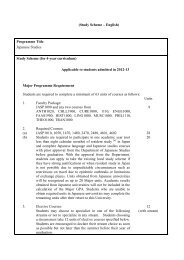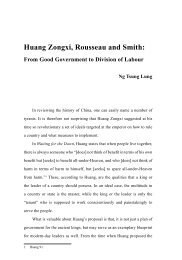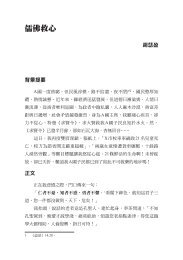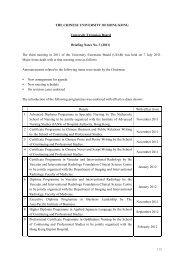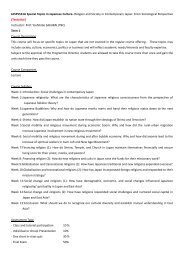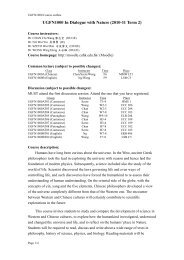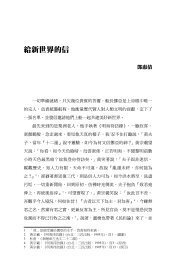ä¸è¼å ¨æ¸ - The Chinese University of Hong Kong
ä¸è¼å ¨æ¸ - The Chinese University of Hong Kong
ä¸è¼å ¨æ¸ - The Chinese University of Hong Kong
You also want an ePaper? Increase the reach of your titles
YUMPU automatically turns print PDFs into web optimized ePapers that Google loves.
Wyman Kwok, Education and Thinking 197<br />
subjects like sociology. Both approaches have valuable things to teach us<br />
about thinking.<br />
In the following sections, the two essential components in the<br />
development <strong>of</strong> CT — cognitive skills and affective dispositions — will<br />
first be explained. <strong>The</strong> author’s own experiences with the process and some<br />
important resources for teaching and learning CT in general will then be<br />
discussed. Finally, some key issues in teaching and learning CT in a specific<br />
subject, and useful references, will be introduced.<br />
What Is Critical Thinking<br />
CT has been defined in a number <strong>of</strong> ways by its prominent scholars<br />
and practitioners. At its core, CT can be defined as follows: CT is a mode<br />
<strong>of</strong> thinking focused on judging right from wrong, distinguishing truth from<br />
falsity. This definition is admittedly a very simple one, which only stresses<br />
two core objectives <strong>of</strong> CT while ignoring its other rich dimensions. However,<br />
it serves to delineate CT from other modes <strong>of</strong> thinking. For example, creative<br />
thinking is a mode <strong>of</strong> thinking focused on generating innovative ideas (e.g.,<br />
the kind <strong>of</strong> thinking that takes place during a brainstorming session to come<br />
up with preliminary ideas for a new advertisement); affective thinking is<br />
a mode <strong>of</strong> thinking focused on effective communication or the sharing <strong>of</strong><br />
feelings and emotions (e.g., the kind <strong>of</strong> thinking that takes place during a<br />
warm gathering <strong>of</strong> old friends); kinetic thinking is a mode <strong>of</strong> thinking focused<br />
on rapidly controlling and adjusting bodily movements (e.g., the thinking that<br />
occurs during a soccer match); and so on. Our daily mode <strong>of</strong> thinking (or our



